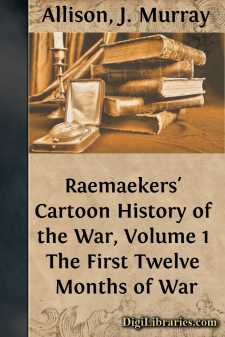Categories
- Antiques & Collectibles 13
- Architecture 36
- Art 48
- Bibles 22
- Biography & Autobiography 813
- Body, Mind & Spirit 142
- Business & Economics 28
- Children's Books 15
- Children's Fiction 12
- Computers 4
- Cooking 94
- Crafts & Hobbies 4
- Drama 346
- Education 46
- Family & Relationships 57
- Fiction 11828
- Games 19
- Gardening 17
- Health & Fitness 34
- History 1377
- House & Home 1
- Humor 147
- Juvenile Fiction 1873
- Juvenile Nonfiction 202
- Language Arts & Disciplines 88
- Law 16
- Literary Collections 686
- Literary Criticism 179
- Mathematics 13
- Medical 41
- Music 40
- Nature 179
- Non-Classifiable 1768
- Performing Arts 7
- Periodicals 1453
- Philosophy 64
- Photography 2
- Poetry 896
- Political Science 203
- Psychology 42
- Reference 154
- Religion 513
- Science 126
- Self-Help 84
- Social Science 81
- Sports & Recreation 34
- Study Aids 3
- Technology & Engineering 59
- Transportation 23
- Travel 463
- True Crime 29
Raemaekers' Cartoon History of the War, Volume 1 The First Twelve Months of War
Description:
Excerpt
FOREWORD
In all the welter of the tragic upheaval which is shattering institutions once thought immutable, condemning millions to physical death and awakening other millions to spiritual life, making staggering discoveries of unexpected human strength or weakness, thrusting men into fame one day or to oblivion the next, there has been nothing more dramatic than the sudden manifestation of the genius of the Dutchman, Louis Raemaekers, who, as Europe recoiled from the first shock of German barbarity, threw down his brush for his pencil and by the intensity of his spirit aroused the compassion and fired the anger of the world with his cartoons of the Belgian violation.
He, more than any other individual, has made intensely clear to the people the single issue upon which the war is joined. More than cartoonist, he is teacher and preacher, with the vision, faith, and intensity of a St. Francis, a Luther, or a Joan of Arc.
On August 1, 1914, we find him a quiet, gentle man, the son of a country editor, happy in his family, devout, contemplative, loving beauty and peace, contentedly painting the good and lovely things he saw among the tulip-fields and waterways, the cattle and the wind-mills of his own native Holland before the gray-clad millions of the Kaiser burst into the low countries with fire and sword.
Then comes the miracle of his transformation; the idyllic is thrust aside by the hideous reality; beauty is drowned in a bestial orgy of force; and in place of the passive painter arises the fiery preacher; the brush is discarded for the pencil, and the pencil in his hands becomes an avenging sword, because by it millions of people have been aroused to a clear-cut realization of the fact that the issue of this war is no less than Slavery and Autocracy versus Freedom and Democracy.
The very first of his war cartoons indicated the prophetic vision of the man, and gave the first evidence of his inspiration and genius. It is called “Christendom after Twenty Centuries” and shows a bowed and weeping figure crouching under the sword and lash. It was drawn on that fateful day August 1st, 1914. The intensity of emotion shown in this drawing revealed his power for the first time. To Raemaekers himself it came as a vision and a summons. The landscape painter disappeared, and in his place arose a champion of civilization, throbbing with sublime rage and pity, clothed with authority, and invested with a weapon more powerful than the ruthlessness it indicts.
When the stories of the Belgian horror began to circulate in Holland, Raemaekers, like the rest of the humane world, refused to credit them. His own mother was German; he had spent many happy years in Germany; he knew the German peasant as a kindly and happy, if rather stupid fellow; it was incredible that such men could have done the awful things alleged. But the tales persisted, and although the evidence of the wracked and broken refugees who poured into his country by tens of thousands seemed irrefutable, he could not believe it, and readily seized upon the common supposition that the terrible stories were the product of the imagination of an overwrought and panic-stricken people....


